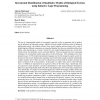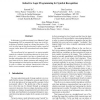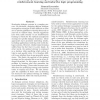32 search results - page 2 / 7 » Taming the Complexity of Inductive Logic Programming |
JMLR
2008
13 years 5 months ago
2008
The use of computational models is increasingly expected to play an important role in predicting the behaviour of biological systems. Models are being sought at different scales o...
ICDAR
2009
IEEE
14 years 4 hour ago
2009
IEEE
In this paper, we make an attempt to use Inductive Logic Programming (ILP) to automatically learn non trivial descriptions of symbols, based on a formal description. This work is ...
NAACL
2001
13 years 6 months ago
2001
Developing dialogue systems is a complex process. In particular, designing efficient dialogue management strategies is often difficult as there are no precise guidelines to develo...
CSL
2004
Springer
13 years 10 months ago
2004
Springer
To reason effectively about programs, it is important to have some version of a transitive-closure operator so that we can describe such notions as the set of nodes reachable from ...
TCS
2011
13 years 6 days ago
2011
New, simple, proofs of soundness (every representable function lies in a given complexity class) for Elementary Affine Logic, LFPL and Soft Affine Logic are presented. The proofs ...



